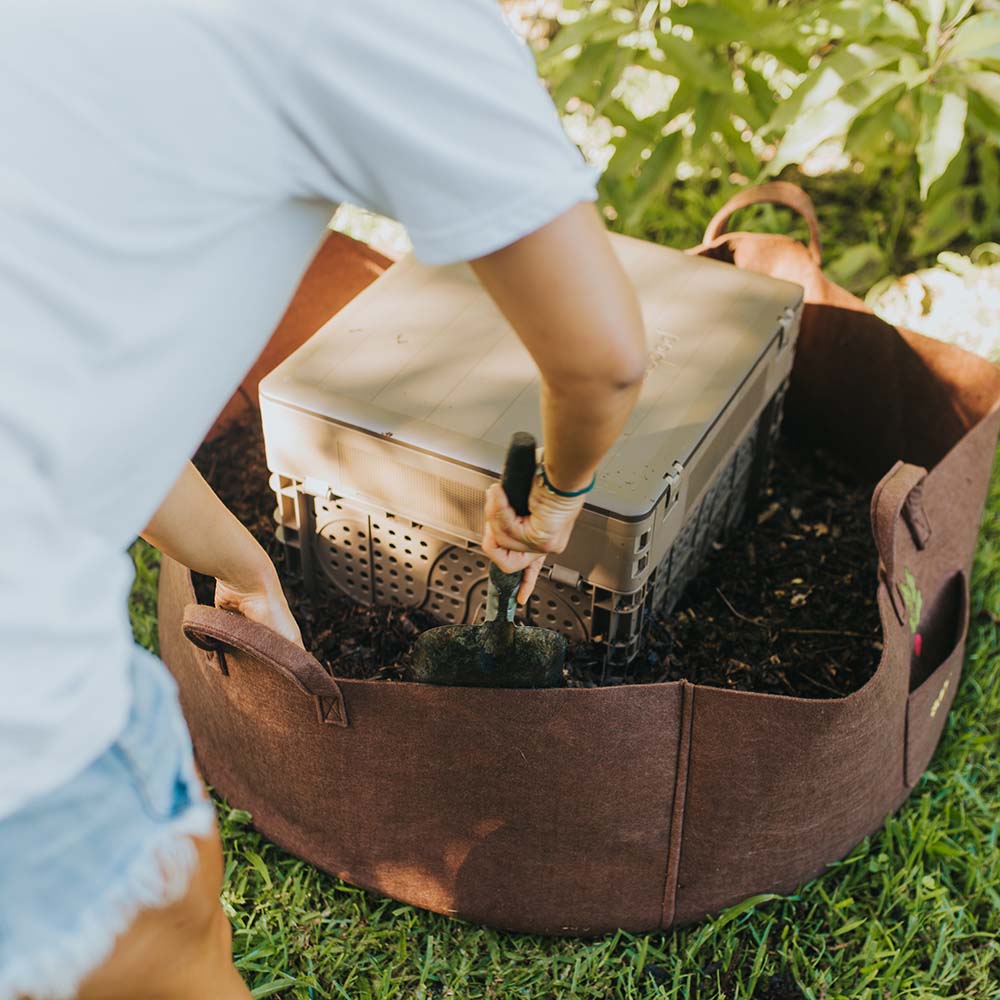Are Tea Bags Compostable?
In this article:
Have you ever wondered whether your tea bags can be composted? Tea is definitely one of nature’s finest gifts to us, one that can be enjoyed over and over again at any time of the day! A cup of tea is relaxing, rejuvenating and refreshing, the perfect mood booster or mindset changer. (Can you tell that we’re fans of tea? Who isn’t!)
If you’re thinking about repaying nature for this amazing gift, you’ve probably asked the question “are tea bags compostable?” It’s a good question because composting is a great way to give back to the planet and help promote a more sustainable environment.
That’s why eco-conscious tea drinkers out there often ask the question, can you compost tea bags? The answer is yes, you can compost SOME of them. But there are some things to bear in mind before , because not all tea bags are built the same and not all of them are kind to your compost bin.

What Type of Tea Bags Can You Compost?
Let’s start off by saying that the delicious, purely organic tea leaves sitting inside the tea bag are 100% compostable. If you make your tea from loose tea leaves, those can simply be added directly to your compost bin.
Tea bags can be a bit more problematic, depending on what they’re made out of. Many are made out of paper, and if that’s all they contain they can be composted without a problem. The paper may be held together with an adhesive though, and it’s important to note the adhesive won’t break down in your compost.
Additionally, there are some tea bags (about 20-30% of all tea bags) out there which are made out of polypropylene plastic, and these can’t be composted. They simply won’t break down in your bin, so it’s best to toss them into the recycling bin instead.
Some tea bags are made out of a mix of plastic and paper, and again you should avoid putting these into your compost bin. The plastic component isn’t biodegradable. The string and the paper tag attached to tea bags are both compostable, but the metal staple joining them can’t be.
How Can You Tell What Your Tea Bags Are Made Of?
There’s a simple trick for deciding whether your tea bags are safe to compost or not. If it is shiny in appearance, then it’s made of plastic. If it’s a dull colour and texture, it’ll be made of paper. It’s always a good idea to check on the box and see what ingredients go into the tea bags. That way you won’t inadvertently add non-organic materials into your compost.
If you put a plastic tea bag into your compost it will take many years to break down. As it does, tiny microplastics will enter the compost, finding their way into the watershed and being absorbed into the plants you grow. You want to avoid having these kinds of toxins in your compost, which is why it's so important to be careful what materials you compost.

Are Tea Bags Considered to be a ‘Green’ or ‘Brown’ Compost Material?
One of the first things you learn when you begin your composting journey is that there are two types of organic materials, ‘brown’ and ‘green’. Greens are nitrogen-rich organic materials, with most of your kitchen food waste falling into this category. You’ll find they are generally wetter, and often green in colour. Fresh grass clippings, pulled weeds and coffee grounds are also examples of green materials.
Brown materials have a high carbon content, and are usually dry and brown in colour. They’re important in maintaining the structure of your compost, helping with aeration and water retention. Examples include sawdust, straw, paper and cardboard, all of which can take a bit longer to break down than green materials.
For your composting efforts to be successful and efficient, your greens and browns need to be properly balanced. Most people will stick to a ratio of two or three parts brown to one part green, but this can be adjusted according to the needs of your compost bin. If things are getting a bit wet in there, you’ll need to add some brown material to dry it out. If it's a bit dry and your worms are moving away, throw some extra green material in.
Ok, that’s your composting 101 lesson concluded. Now back to the question… are tea bags a green or brown compost material? This is an interesting one, because it comes in two parts. The tea within the tea back is high in nitrogen and would most definitely be considered green. But the paper the tea bag is made of is high in carbon, so would be brown.
Why Are Tea Bags A Great Addition to Your Compost?
What we’ve learned from the above section is that tea bags are a pre-packaged mix of brown and green! No wonder biodegradable tea bags are so good for composting! Let’s look at some other reasons why tea leaves are an important addition to your compost bin. Have you heard the term ‘steeped’ tea bags? Ever wondered what it meant? A steeped tea bag is basically one that has been added to water and had the flavours diffuse out into the surrounding liquid. Which is exactly what tea bags are designed for!
Most of the time you’ll be tossing steeped tea bags into your compost bin. As we’ve discovered, the bags and leaves are an excellent source of organic material for the composting process. The leaves have nitrogen, potassium and phosphorus, and the bags are rich in carbon. The moisture from the steeping process also helps maintain the moisture levels in your compost bin.
Composting tea is a process, and it starts with making your cup of tea and drinking it. Enjoy! Then, it’s time to put your tea bags into the compost caddy or bin. There are a couple of steps to follow here:
- Ascertain whether the tea bag contains any plastic or not. Do a visual check for shininess, and then check the packaging to see if there is plastic in the ingredients.
- If there is plastic present, simply cut open the tea bag and compost the leaves only.
- If the bag is made entirely of paper, the whole thing can go in the compost bin, including the string and paper tag.
- If there is a metal paper clip on the tea bag, we’d suggest removing this before composting.
That’s it… pretty easy, right?
Is There a Difference Between Composting Dry and Steeped Tea Bags?
A steeped tea bag may still be fairly hot once you take it out of the kettle or pot. You may want to let it sit for a while to get to room temperature before composting it. You could also toss it into the compost caddy with the other food waste from your kitchen, and make a daily trip out to your compost bin. You want composting to be an easy part of your everyday life, so avoiding multiple trips to the compost bin every day is key to this happening!
There are no precautions to take with composting dry tea bags, but you might want to check the moisture content in your compost bin if you’re adding a lot of dry tea bags. If it’s already a bit dry in there, make sure to include some greens too to balance out the moisture content.
What Tea Brands are Producing Compost Friendly Tea Bags?
A bit of forward planning in your product selection really helps when it comes to the sustainability of your household. With tea bags, you want to look for the brands creating 100% eco-friendly and biodegradable ones. Or, if you have a brand you love and they’re not that eco-friendly, be prepared to dedicate a bit of time dismantling the tea bag and only composting the leaves!
To help you out, this list tells you which brands make compostable tea bags and which don’t:
Pukka: Although a thin lining of plastic coats the tea envelope, Pukka claim to be 100% confident their tea bags can be composted.
Republic of Tea: This brand is completely recyclable, using unbleached filter paper in their bags. They’re also gluten free!
Numi Organic Tea: Numi tea bag wrappers are completely compostable, designed to be biodegradable while causing no eco-toxicity.
Twinings: No, these aren’t compostable as they contain plant-based plastic PLA.
Tetley: Tetley are making a transition to fully biodegradable tea bags, but at this stage they still have some plastic in them.
How to Compost Tea Bags With Subpod
No matter what organic waste out of your household you’re composting, Subpod is a great way to do it. It’s efficient, easy-to-use and can adapt to any outdoor space while looking good at the same time!
Subpod relies on a system called vermicomposting to break down your food waste into compost. Thousands of worms and microbes live in your Subpod, and when you add your food waste they go to work, transforming it into nutrient-rich ‘back gold’ compost that gardeners love.
When you’re composting tea bags, you simply place them into your Subpod with your other kitchen waste. Worms and microbes are very efficient in their creation of compost, so over a short period of time you can watch the tea disappear!
Subpod is a beginner-friendly solution that takes minutes to set up. Once established in your garden, composting will only take a few minutes out of your week. It’s a very urban-friendly means of composting, because not only does it not take up much room, but it’s smell and pest resistant too! Your neighbour will love it, especially when you share your compost with them!
There are over 60,000 Subpods in action around the world. Many of those owners and compost enthusiasts can be found on our GrowHub channel. If you have any questions about composting tea bags, or anything else, you’ll definitely get an answer over there!





